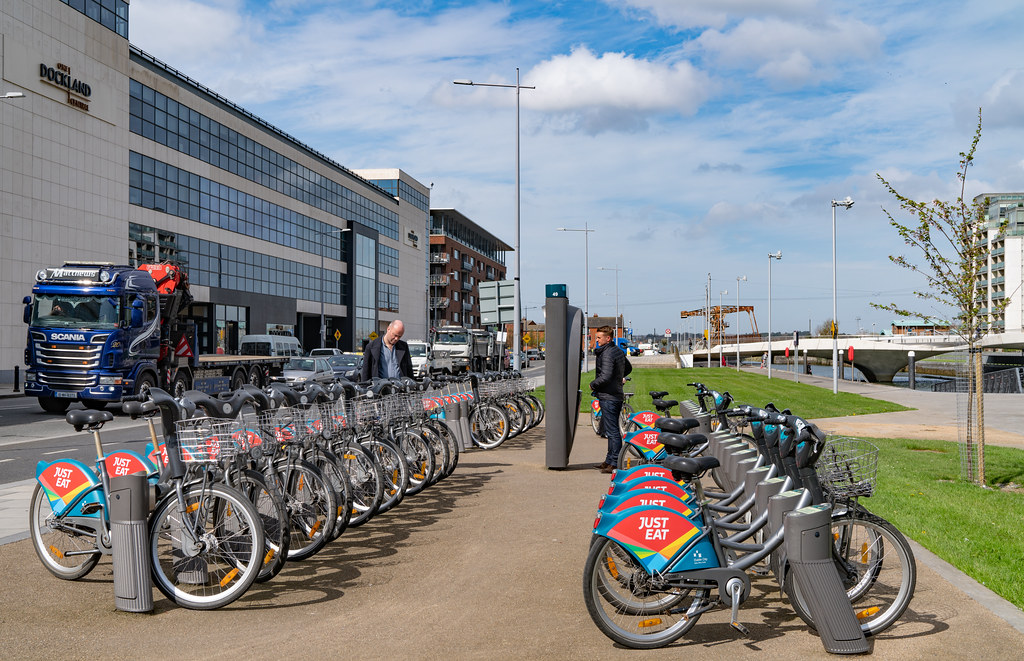DOCKING STATION 49
This is located beside one of two Scherzer Bascule Bridges on the North Wall Quay.
A bascule bridge is a moveable bridge with a counterweight that continuously balances a span, or "leaf", throughout its upward swing to provide clearance for boat traffic. It may be single or double leafed.
The name comes from the French term for balance scale, which employs the same principle. Bascule bridges are the most common type of movable span because they open quickly and require relatively little energy to operate, while providing the possibility for unlimited vertical clearance for marine traffic.
There are three types of bascule bridge designs, and counterweights required to balance a bascule's span may be located either above or below the bridge deck.
The fixed-trunnion (sometimes a "Chicago" bascule) rotates around a large axle that raises the span(s). The Chicago bascule name derives from the location where it is widely used, and is a refinement by Joseph Strauss of the fixed-trunnion.
The rolling lift trunnion (sometimes a "Scherzer" rolling lift), raises the span by rolling on a track resembling a rocking chair base. The "Scherzer" rolling lift is a refinement patented in 1893 by the American engineer William Donald Scherzer.
The rarer Rall type combines rolling lift with longitudinal motion on trunnions when opening.[4] It was patented (1901) by Theodor Rall. One of the few surviving examples is the Broadway Bridge (1913), in Portland, Oregon.
A bascule bridge is a moveable bridge with a counterweight that continuously balances a span, or "leaf", throughout its upward swing to provide clearance for boat traffic. It may be single or double leafed.
The name comes from the French term for balance scale, which employs the same principle. Bascule bridges are the most common type of movable span because they open quickly and require relatively little energy to operate, while providing the possibility for unlimited vertical clearance for marine traffic.
There are three types of bascule bridge designs, and counterweights required to balance a bascule's span may be located either above or below the bridge deck.
The fixed-trunnion (sometimes a "Chicago" bascule) rotates around a large axle that raises the span(s). The Chicago bascule name derives from the location where it is widely used, and is a refinement by Joseph Strauss of the fixed-trunnion.
The rolling lift trunnion (sometimes a "Scherzer" rolling lift), raises the span by rolling on a track resembling a rocking chair base. The "Scherzer" rolling lift is a refinement patented in 1893 by the American engineer William Donald Scherzer.
The rarer Rall type combines rolling lift with longitudinal motion on trunnions when opening.[4] It was patented (1901) by Theodor Rall. One of the few surviving examples is the Broadway Bridge (1913), in Portland, Oregon.

DUBLIN BIKES STATION 49 ON GUILD STREET
You will find links to buy products from Amazon, Google and other partners. If you click on these links, you’ll find that the URL includes a small extra piece of text which identifies that the click came from my websites. This text is an affiliate code, and it means that I get a small percentage of the money you spend if you choose to buy that product, or, in some cases, other products from the site soon after. These affiliate links help pay the costs of producing my websites and ensure that the content is free to you.
COPYRIGHT INFORMATION BELOW APPLIES ONLY TO PHOTOGRAPHS

This work by William Murphy aka Infomatique is licensed under a Creative Commons Attribution-NonCommercial-ShareAlike 4.0 International License.
Permissions beyond the scope of this license may be available at https://excellentstreetimages.com/in-the-year-twentytwenty/copyright/.
